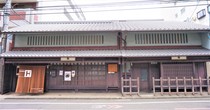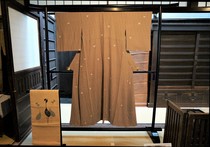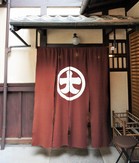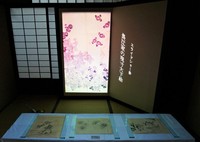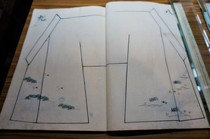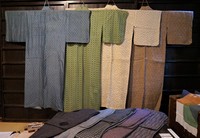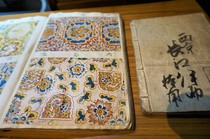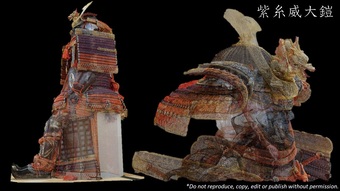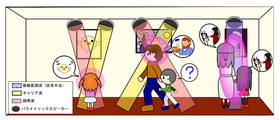-
 19
20
21
22
23
24
25
26
27
28
29
19
20
21
22
23
24
25
26
27
28
29

 With the establishment of the International Joint Digital Archiving Center for Japanese Art and Culture (ARC-iJAC) in 2019, the Art Research Center strives to push the internationalization of research activities that transcend disciplines and geographic boundaries.
With the establishment of the International Joint Digital Archiving Center for Japanese Art and Culture (ARC-iJAC) in 2019, the Art Research Center strives to push the internationalization of research activities that transcend disciplines and geographic boundaries.



NEWS
 Since its establishment in 1998, the ARC has been publishing the bulletin every year in March with the purpose of widely publicizing the research activities and outcomes of the center's projects. >>Read the bulletin
Since its establishment in 1998, the ARC has been publishing the bulletin every year in March with the purpose of widely publicizing the research activities and outcomes of the center's projects. >>Read the bulletin
Interview with Prof. Takanobu Nishiura (College of Information Science and Engineering, Ritsumeikan University)  Furthermore, he introduces the concept of space-sharing through flexible audio spot technology.
Furthermore, he introduces the concept of space-sharing through flexible audio spot technology.
>> Read full interview The museum is home to the collections of Philipp Franz Balthasar von Siebold, Jan Cock Blomhoff (Head of the Dutch East India Company in Dejima), and others.
The museum is home to the collections of Philipp Franz Balthasar von Siebold, Jan Cock Blomhoff (Head of the Dutch East India Company in Dejima), and others.
The extensive collection of Japanese artifacts includes ukiyo-e prints, copperplate prints, and early Japanese books. >> Enter the database On March 22 & 21, the ARC co-organized a special exhibition at the Nagae Family Residence, a tangible cultural property designated by Kyoto City.
On March 22 & 21, the ARC co-organized a special exhibition at the Nagae Family Residence, a tangible cultural property designated by Kyoto City.
Items on display included kimonos, historical trading documents, and daily necessities from the Nagae family collection. They were made publicly available for the first time, providing a glimpse into the daily life and business of a kimono fabric wholesaler in the early Shōwa era. >>Read more
They were made publicly available for the first time, providing a glimpse into the daily life and business of a kimono fabric wholesaler in the early Shōwa era. >>Read moreDigital Archiving Project about Pre-war Theater Programs of the Kabuki-za, Tokyo, held by the Shochiku Otani Library  As part of this research project, adopted by the ARC-iJAC, the bound pre-war theater programs of the Kabuki-za are dismantled into single volumes to prepare them for digital photography which the ARC Studio has documented in the above video.
As part of this research project, adopted by the ARC-iJAC, the bound pre-war theater programs of the Kabuki-za are dismantled into single volumes to prepare them for digital photography which the ARC Studio has documented in the above video.
The digitized programs will be integrated into the Shochiku Otani Library's Shibai Banzuke Browsing System and made available online. >>Read moreFY2020 Annual Report Meeting of the ARC-iJAC & Program for Supporting Research Center Formation
& FY2021 ARC-iJAC Adopted Joint Research Projects Concluding the fiscal year, the FY2020 Annual Report Meeting was held on February 19 & 20, 2021 via Zoom and YouTube.
Concluding the fiscal year, the FY2020 Annual Report Meeting was held on February 19 & 20, 2021 via Zoom and YouTube.
Furthermore, we have announced the FY2021 Adopted Joint Research Projects of the ARC-iJAC.
FY2020 ARC-iJAC Project Spotlights
Background interview with Andrew Gerstle (Emeritus Professor, SOAS University of London, UK & Project Leader). >> Read more  Background interview with Akihiro Tsukamoto (Associate Professor, Tokushima Univ., Japan & Project Leader). >>Read more
Background interview with Akihiro Tsukamoto (Associate Professor, Tokushima Univ., Japan & Project Leader). >>Read more

Upcoming Events
Wednesday, April 28, 2021, 18:00-19:30
83rd International ARC Seminar (Webinar)
1. The Problem of Distance in Digital Art History: Using the ResearchSpace Knowledge system to capture research methods and thinking (in English) Abstract→
Speaker: Dominic Oldman
(Head of ResearchSpace & Senior Curator, British Museum, UK)
2. Various Needs of Chinese Classics in East Asia / 東アジアにおける漢籍需要の多様性 (in Japanese)
Speaker: Riku Tono
(Assistant Professor, Kinugasa Research Organization, RU)

Previous Issues:
Winter Newsletter 2020
Autumn Newsletter 2020
Summer Newsletter 2020
Spring Newsletter 2020view this email in your browser Copyright © 2021 Art Research Center, Ritsumeikan University. All rights reserved.
Our mailing address is:
56-1 Toji-in Kitamachi, Kita-ku, Kyoto 603-8577 JAPAN
Want to change how you receive these emails?
You can update your preferences or unsubscribe from this list.[イベント情報]April 14, 2021(Wed)Professor Gerstle, thank you for your time today.
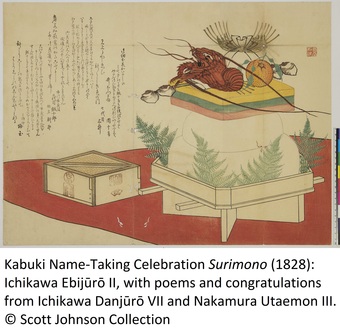
As the leader of the FY2020 ARC-iJAC project "Cultural Salons and the Visual Arts in Kyoto and Osaka, 1750-1900: Digitizing Kamigata Surimono and Paintings", could you please tell us the reason why you started this project?
Prof. Gerstle: I have been fascinated over the years by discovering how common it was in the Edo period for men and women of all ages and statuses to be active in cultural pursuits (遊芸) for pleasure.
I first realized this in researching gidayū amateur performance, where I found that until World War II gidayū as a hobby was popular all over Japan. I then saw how kabuki actors circulated among patrons and fans via haikai gatherings. Pursuit of the arts also importantly was a way for women as well to socialize outside their neighbourhood, and for individuals of different status (身分) to interact.
I still find it intriguing that individuals often had several pen names for their different activities. Under a pen name, everyone was nominally equal as a devotee of the particular art they were participating in. In contemporary Japan, we still see that it is common to socialize through cultural or other organized activities, like the clubs at university.
Read more>>[イベント情報]April 6, 2021(Tue)The Art Research Center (ARC) co-organized the special exhibition Kimono no Mushiboshi (「着物の虫干し展」) at the Nagae Family Residence, a tangible cultural property designated by Kyoto City, on March 20 and 21, 2021.
Due to COVID-19, this was the first time since the byobu matsuri (folding screen festival) in summer 2019 that the residence was open again to the public, and it welcomed a total of 50 visitors.
About the Event
The Nagae family were merchants of the kimono fabric, and their family residence served as both a working and living space for many generations.
During this exhibition at the residence, kimonos from the family collection were taken from the storehouse and air-dried--a traditional Japanese practice called mushiboshi--to prevent the clothes from insects and mold.
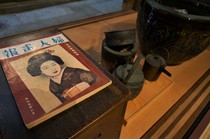
These kimonos were worn by the seventh generation of the Nagae family during the early Shōwa period. The head of the seventh generation was very fond of the Gion Festival, participating in the festival's preservation society and as a musician for the Gion bayashi (orchestral music accompanying the festival). He wore the summer haori on display to attend various events of the Gion Festival.
Furthermore, tools, goods, and trading documents were exhibited, providing a glimpse into the daily life and business of a merchant family in the rakuchu (in the capital) of that time.
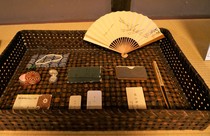
The items from the family collection displayed at this event were made available to the public for the first time after they had remained in the storehouse for a long time.
In a separate room, visitors could learn about the ARC's research outcomes in digital-archiving the Nagae family collection.
About the Nagae Family Residence
Designated as a tangible cultural property by the City of Kyoto, the Nagae Family Residence was built between the late Edo period and the Taishō period and is located in the center of Kyoto.
The main building is a two-story traditional wooden townhouse--also referred to as kyo-machiya--which consists of a north wing constructed in 1868 (closed to the public) and a south wing constructed in 1905.
Although some parts of the building have been restored in recent years, most parts of the residence, including the glass windows, remain the same as built more than a century ago.
With the office space at the front and private rooms at the back, including one for ceremonial occasions, each room had a clearly defined function.
Furthermore, a family business trademark is found throughout the residence that differs from the kamon (family crest) printed on their kimonos for the Gion Festival.
About the ARC's Research
The ARC has been involved in the research on the Nagae Family Residence for many years. After receiving a donation of their collection, including hanging scrolls, folding screens, kimonos, and daily life tools, we have been researching and digital-archiving those items.
In recent years, some kimonos and design pattern books have been discovered in the storehouse, revealing new aspects of the Nagae family's business as kimono fabric merchants. We also introduced these new findings at this exhibition.
In the future, the ARC strives to continue to research and digital-archive the remaining items in the storehouse to enrich the Nagae family collection database and preserve Japanese cultural heritage.
Nagae Family Residence Links: Official Website Facebook Page Instagram
___________________
Organizer: Hoosiers Corporation
Co-organizer: Art Research Center, Ritsumeikan University
[イベント情報]April 5, 2021(Mon)[イベント情報]March 31, 2021(Wed)The Art Research Center (ARC), Ritsumeikan University, has been actively promoting cooperative research between the humanities and cutting-edge information technology, with a strong focus on digital archiving of Japanese cultural properties, both tangible and intangible. The ARC has been selected as an International Joint Usage/Research Center Program by the Ministry of Education, Culture, Sports, Science and Technology, Japan, in October 2019.
With the establishment of the Digital Archive Research Center for Japanese Cultural Resources, we are pleased to invite researchers to submit joint research proposals to facilitate research and/or utilization of Japanese cultural resources through their digital archiving and database building.→Guidelines for FY 2020 Joint Research to Utilize the Center's Facilities and Equipment
GUIDELINES
Eligibility
The research leader of the joint research team should be a faculty member/researcher/curator who belongs to a university or a research institution within and outside Japan.
Note: a graduate student cannot be a leader.The joint research team as an organization
1. A research team consists of a researcher (its research leader) or researchers (its research leader and co-researchers).
2. While it is recommended that the team include a faculty member of the Art Research Center* as its team member, you can apply without an ARC member, as well. If that is the case, we may assign a member to join the team as its coordinator.
*In this case, the ARC faculty does not include senior researchers, postdoctoral fellows, researchers, and visiting researchers.3. You can recruit (an) additional member(s) after your proposal is selected. The ARC will assist the recruitment.
Research period
The date when your research proposal is accepted to the end of the fiscal year
Contact us
E. NAKAMURA, Y. FUKATSU and K.MURAI
Office of the Art Research Center
Research Office at Kinugasa Campus
Ritsumeikan University
E-mail:r-darc (at) st.ritsumei.ac.jp (change "at" to @)[イベント情報]March 26, 2021(Fri)A research project of the Shochiku Otani Library, adopted by the ARC-iJAC, to digitize and publish the pre-war programs of the Kabuki-za Theatre in Tokyo held by the library has been launched at the Art Research Center, Ritsumeikan University. These programs are also called ehon yakuwari (絵本役割) and sujigaki (筋書).
In preparation for digital photography, the bound programs are currently dismantled into single volumes by having their glue and fasteners removed. It is also a crucial part of the digitization process to examine the condition of the materials beforehand and to dismantle and repair them as necessary.
When a book is split into single volumes, it is possible to photograph the individual pages in a flat position by pressing them evenly against a glass plate from above, resulting in beautiful images with minimum distortion.
Please watch our video documenting this process on the ARC-iJAC's video platform ARCtube:
This digital archiving project is funded through a crowdfunding campaign launched by the Shochiku Otani Library in 2020.
Based on the agreement between the Shochiku Otani Library and the Art Research Center, Ritsumeikan University, the digitized programs will be integrated into the Shochiku Otani Library's Shibai Banzuke Browsing System and made available online.
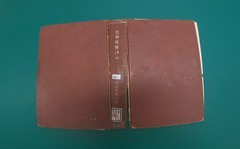 The cover of a dismantled Kabuki-za sujigaki from 1941.
The cover of a dismantled Kabuki-za sujigaki from 1941. Single volumes of the dismantled Kabuki-za sujigaki from 1941.[イベント情報]March 25, 2021(Thu)
Single volumes of the dismantled Kabuki-za sujigaki from 1941.[イベント情報]March 25, 2021(Thu)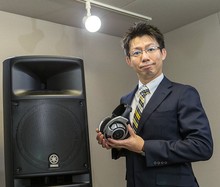 Professor Nishiura, thank you for your time today. Can you please tell us more about your area of research?
Professor Nishiura, thank you for your time today. Can you please tell us more about your area of research?Prof. Nishiura: I joined the College of Information Science and Engineering at Ritsumeikan University in 2004. My research focuses on acoustic signal processing, acoustic systems, and sound interfaces, amongst others.
I conduct integrated research on the analysis, understanding, reproduction, and synthesis of a sound environment to improve society through sound. My goal as a researcher is to create a sound environment for people to live comfortably.
Could you please elaborate on this?
Prof. Nishiura: A practical example may be the visit to the dentist. Many people feel uncomfortable with the dental drilling sound. I have researched and developed a technology of sound esthetics, also called noise-masking so that people are not bothered by the unwanted noise by overlapping it with a pleasant sound.
Furthermore, I have been investigating audio spot technology, a technique to transmit sound only in a specific area. Loudspeakers utilizing ultrasound waves have a higher directivity and can form a narrow audible area to a particular listener, i.e., the audio spot.
This is useful for exhibitions at museums, for example, when you would like to give visitors information relevant to each exhibited object.
Read more>>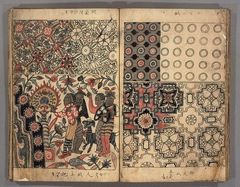 Dutch Textiles in Global History: Interconnections of Trade, Design, and Labour, 1600-2000
Dutch Textiles in Global History: Interconnections of Trade, Design, and Labour, 1600-2000Date: March 11 & 12, 2021
Time: 9:00-12:30 CET (17:00-20:30 JST)
Venue: via Zoom
The online workshop "Dutch Textiles in Global History: Interconnections of Trade, Design, and Labour, 1600-2000" is co-organized by the ARC with colleagues from Utrecht University (the Netherlands) and Hosei University, Tokyo. During this workshop, an interdisciplinary range of scholars will discuss the role of Dutch textiles in global markets from the seventeenth century to the late twentieth century.
Click here for the preliminary program.
Click here for the abstracts.
Registration: Should you be interested in attending the workshop, please fill out this contact form with Subject: "Workshop March 2021".
[イベント情報]March 4, 2021(Thu) As part of our project to digital-archive overseas artworks, the Art Research Center (ARC) is pleased to announce that all of the digitized Japanese cultural materials in the collection of the Rijksmuseum Volkenkunde, Leiden (the Netherlands), including ukiyo-e prints, copperplate prints, and early Japanese books, have been released with the approval of the museum. This time, the published materials comprise mainly paper-based printed and painted materials.
As part of our project to digital-archive overseas artworks, the Art Research Center (ARC) is pleased to announce that all of the digitized Japanese cultural materials in the collection of the Rijksmuseum Volkenkunde, Leiden (the Netherlands), including ukiyo-e prints, copperplate prints, and early Japanese books, have been released with the approval of the museum. This time, the published materials comprise mainly paper-based printed and painted materials.https://www.arc.ritsumei.ac.jp/lib/vm/RV/
As is well-known, the Rijksmuseum Volkenkunde (National Museum of Ethnology), Leiden, is home to an extensive collection of Japanese artifacts comprising the collections of Philipp Franz Balthasar von Siebold, Jan Cock Blomhoff (Head of the Dutch East India Company in Dejima), and others. Since the Netherlands was the only country in Europe that traded with Japan during the Edo period, many Japanese collections have been accumulated there. Hence, many researchers of Japanese culture visit the museum to study its collection.
While the museum's collection is also available through the collection database of the Dutch Nationaal Museum van Wereldculturen, organized along with two other Dutch museums, the ARC's database now provides centralized access for the Japanese to the materials of Rijksmuseum Volkenkunde, Leiden. For each of the materials, there is a button to access the Nationaal Museum van Wereldculturen directly so that explanatory data in the original database can be viewed with a single click. At the same time, the materials can be accessed via the ARC's Portal Database, allowing you to compare them with those from other institutions.
We hope that you will find this information useful.
[イベント情報]March 1, 2021(Mon)The Art Research Center (ARC), Ritsumeikan University, is delighted to announce the release of its PV, introducing the center's diverse international research activities in Japanese art and culture since its establishment in 1998.
Please enjoy the video and feel free to share it.
[Short version]
[Long version]
 19
20
21
22
23
24
25
26
27
28
29
19
20
21
22
23
24
25
26
27
28
29




